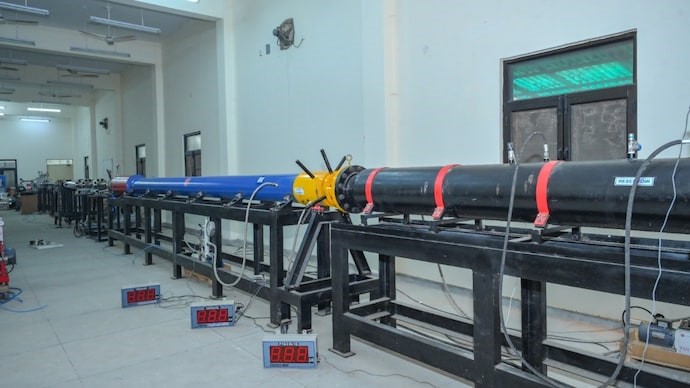Description

Disclaimer: Copyright infringement not intended.
Context
The Indian Institute of Technology Kanpur (IITK) has achieved a significant milestone by establishing and testing India’s first Hypervelocity Expansion Tunnel Test Facility, named S2.
Details
- Capabilities of S2:
- The S2 facility is capable of generating flight speeds between 3-10 km/s.
- It simulates hypersonic conditions encountered during various scenarios, including atmospheric entry of vehicles, asteroid entry, scramjet flights, and ballistic missiles.
- The facility is essential for ongoing missions of ISRO and DRDO, including Gaganyaan, RLV, and hypersonic cruise missiles.
- Location and Nickname:
- S2, nicknamed 'Jigarthanda', is situated at IIT Kanpur’s Hypersonic Experimental Aerodynamics Laboratory (HEAL) within the Department of Aerospace Engineering.
- The 24-meter-long facility is a testament to indigenous design and development over three years.
- Support:
- Funding and support were provided by the Aeronautical Research and Development Board (ARDB), the Department of Science and Technology (DST), and IIT Kanpur.

Introduction to Sonic Speeds
- Sonic speed, also known as the speed of sound, is the rate at which sound waves propagate through a medium.
- It is a fundamental property influenced by the properties of the medium, such as its density, elasticity, and temperature.
Factors Affecting Sonic Speed:
- Medium: The speed of sound varies depending on the medium through which it travels, such as air, water, or solids.
- Temperature: In gases, the speed of sound increases with temperature due to increased molecular motion, while in liquids and solids, it generally increases with temperature but to a lesser extent.
- Pressure: Changes in pressure affect the density and compressibility of the medium, thus impacting the speed of sound.
- Humidity: Moisture content in the air can affect its density and thus influence the speed of sound.
Significance and Effects of Sonic Speeds:
- Aeronautics: Understanding sonic speeds is crucial in aviation for determining aircraft performance, including takeoff, landing, and the formation of shock waves during supersonic flight.
- Meteorology: Sonic speeds influence atmospheric phenomena such as the propagation of sound waves, the formation of thunderstorms, and the behavior of weather fronts.
- Underwater Acoustics: In underwater environments, the speed of sound affects communication, navigation, and the detection of underwater objects.
- Material Testing: Sonic speeds are used in non-destructive testing techniques like ultrasonic testing to detect flaws or defects in materials.
- Medical Imaging: Ultrasonic imaging techniques utilize the speed of sound to create images of internal body structures in medical diagnostics.
Applications of Sonic Speeds:
- Supersonic and Hypersonic Flight: Sonic speeds play a crucial role in the design and operation of supersonic and hypersonic aircraft, including military jets and experimental spaceplanes.
- Sonar Systems: Underwater sonar systems utilize the speed of sound to detect and locate objects underwater, including submarines, marine life, and geological features.
- Ultrasonic Cleaning: Ultrasonic cleaners use high-frequency sound waves to remove dirt and contaminants from surfaces in industrial and household applications.
- Acoustic Levitation: Sonic speeds are used in acoustic levitation techniques to suspend and manipulate objects without physical contact, with applications in materials science and microgravity research.
Speed of Sound in Air:
- The speed of sound in air varies with temperature, humidity, and pressure.
- At room temperature (around 20°C or 68°F), the speed of sound in dry air is approximately 343 meters per second (m/s) or 1,235 kilometers per hour (km/h).
- As temperature increases, the speed of sound in air also increases, due to the increased molecular motion.
Speed of Sound in Water:
- The speed of sound in water is much faster than in air, as water is denser and more elastic.
- At room temperature, the speed of sound in water is about 1,480 m/s (approximately 5,350 km/h), which is about four times faster than in air.
- The speed of sound in water also varies with factors such as temperature, salinity, and pressure.
Speed of Sound in Solids:
- Sound travels even faster through solids due to their higher density and elasticity.
- The speed of sound in solids varies depending on the material.
- In steel, the speed of sound can range from about 5,900 m/s (21,240 km/h) to 6,700 m/s (24,120 km/h).
- In diamond, it can be as high as 12,000 m/s (43,200 km/h) or more.
Supersonic Speed:
- Supersonic speed refers to speeds faster than the speed of sound in the medium.
- In air at sea level conditions, this is typically speeds greater than about 343 m/s (approximately 1,235 km/h).
- Aircraft traveling at supersonic speeds generate shock waves and can produce a characteristic "sonic boom."

Hypersonic Speed:
- Hypersonic speed refers to speeds significantly faster than the speed of sound.
- In the context of atmospheric flight, hypersonic speeds are generally considered to be speeds greater than Mach 5 (five times the speed of sound) or about 1,715 m/s (approximately 6,174 km/h).
- Hypersonic flight presents significant engineering challenges due to extreme temperatures, aerodynamic heating, and shock wave interactions.
Transonic Speed:
- Transonic speed refers to speeds near the speed of sound, where airflow around an object begins to approach and exceed the speed of sound.
- In aerodynamics, transonic flight occurs in the range of Mach numbers from about 0.8 to 1.2.
- At transonic speeds, airflow phenomena such as shock waves, compressibility effects, and drag divergence become significant.
|
PRACTICE QUESTION
Q. Which of the following statements regarding sonic speeds is correct?
1. Sonic speed refers to the speed of light in a vacuum.
2. Sonic speed is the maximum speed attainable by any object in motion.
3. Sonic speed is the speed at which sound waves propagate through a medium.
4. Sonic speed is inversely proportional to the density of the medium.
Options:
A) 1 and 2
B) 2 and 3
C) 3 and 4
D) 1 and 4
Correct Answer: C)
|











